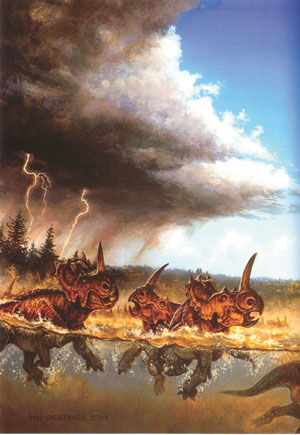
The largest dinosaur bonebed ever unearthed is providing evidence that the dinosaurs were wiped out in catastropic coastal storms, new findings published this month report.
A bonebed containing thousands of Centrosaurus apertus, a horned relative to Triceratops as been found near Hilda, 50 kilometres north of Medicine Hat.
“Data from this mega bonebed provide pretty clear evidence that these, and other dinosaurs, were routinely wiped out by catastrophic tropical storms that flooded what was once a coastal lowland here in Alberta, 76 million years ago,” says David Eberth, Senior Research Scientist at the Royal Tyrrell Museum, the lead author on the study and one of New Perspectives On Horned Dinosaurs, which published the findings this month.
Covering an area of at least 2.3 square kilometres (the size of 280 football fields), the Centrosaurus beds aren’t new findings in Alberta, but is the largest yet discovered.
The massive deathbeds of the beasts help paint a picture of the prehistoric coastal landscape that existed in Alberta was submerged in water.
This is seen as probably leaving the dinosaurs with no high ground to escape the floods, that can be compared to the floods Bangladesh experience every year.
“It’s unlikely that these animals could tread water for very long, so the scale of the carnage must have been breathtaking,” says Eberth.
“The evidence suggests that after the flood, dinosaur scavengers trampled and smashed bones in their attempt to feast on the rotting remains.”
The mega bonebed also helps explain why dinosaurs are so abundant in Alberta’s Badlands, and also gives clues that there was in fact dinosaurs that herded in large numbers.
The Tyrrell estimates that the number of dinosaurs in the area could be in the high hundreds to low thousands.
According to the team, coastal plain floods, like those that afflict modern Bangladesh, occur on a geographic scale that is so vast that they often kill large varieties and numbers of the larger terrestrial animals, regardless of whether they live solitary lives or spend their time in large herds.
“Because of their size and the scale of the flooding, dinosaurs could not escape the coastal floodwaters and would have been killed in large numbers. In contrast, fish, small reptiles, mammals, and birds may have been able to escape such seasonal catastrophes by retreating to quiet water areas, the safety of trees and burrows, or simply by flying away.”
“We’ve known about the Hilda mega bonebed since the late 1990’s, but the complexities of the project prevented us from documenting and publishing on it for almost 10 years.”




























